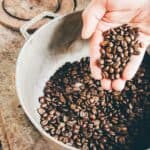Wet vs Dry Cappuccino: Explained!

The Cappuccino is one of the most popular coffee based drinks out there! Cappuccinos have a long, rich history and have a reputation for being silky smooth, multilayered and delicious!
But, there are actually a couple of variations to the cappuccino that many coffee lovers may want to experiment with!
So, if you are interested in finding out more about different types of cappuccino and how you can change things up to keep your morning coffee fresh and interesting, you’ve come to the right place!
What is a Cappuccino?

A cappuccino is a coffee drink made from a double shot of espresso (typically made from dark roasted coffee beans), hot, steamed milk and milk foam. A cappuccino is made using ⅓ espresso, ⅓ steamed milk, and ⅓ milk foam.
Whilst the traditional cappuccino recipe calls for equal measurements of espresso, steamed milk and foam, the ratios and ingredients can be altered to suit the drinker. Some people prefer a single shot of espresso as opposed to a double, some prefer less foam and some prefer using milk alternatives.
As we will explore later on in this article, there are a number of great cappuccino alternatives to try if you are bored of the regular version. However, they all follow the same formula of combining fluffy foam, silky smooth milk and bold espresso!
Wet vs Dry Cappuccino: Explained!

You may be thinking, how can a cappuccino be made wet or dry?! This is still a liquid, coffee based drink right?
Yes, both a wet and dry cappuccino are espresso based drinks, made using steamed milk and foam. However, the adjustment in ratios of steamed milk to foam is what gives these cappuccino variations their strange names.
So, let’s take a closer look at what separates a wet from a dry cappuccino!
Wet Cappuccino
A ‘wet cappuccino’ may sound like quite a strange name for a coffee based drink. Afterall, aren’t all coffees technically wet?!
Well, the term ‘wet cappuccino’ refers to an altered version of a regular cappuccino, which has a higher ratio of steamed milk and a lower ratio of foam. This makes a wet cappuccino relatively similar to a latte, but it still contains a little bit more foam overall.
If you think about it, technically the relatively high volume of foam used to make a traditional cappuccino means you are drinking less liquid overall compared to a latte for example. You will have the residual foam left at the bottom of your cup, that is often scooped up and enjoyed at the end.
But, all that room in your coffee cup is being taken up by foam, rather than milk or espresso. So, increasing the amount of steamed milk used in a wet latte, does actually mean you’re consuming more liquid than foam. So, whilst the term ‘wet cappuccino’ sounds a bit odd, it does actually make sense!
Dry Cappuccino
A ‘dry cappuccino’ takes the same philosophy used to make a wet cappuccino, but increases the ratio of foam, whilst decreasing the ratio of steamed milk. A dry cappuccino gets its name from the lack of steamed milk and hefty helping of foam that tops the double shot of espresso.
Since milk foam is heavily aerated and therefore doesn’t contain much liquid, using such a large amount of it with just a small 2 oz double shot of espresso makes a dry cappuccino quite a strong coffee.
Also, the drinking experience is quite different to a regular cappuccino.
You’ll find that the strong, earthy, bitter espresso cuts through the foam and doesn’t take much of it along for the ride before entering your mouth! Whilst there is a small layer of steamed milk between espresso and foam, this doesn’t do much to offset the coffee’s natural bitterness! Therefore, a dry cappuccino is a much stronger drink that you have to really mix up a lot to combine the foam and espresso together.
Bone Dry Cappuccino
Another variation of the traditional cappuccino is the bone dry version. This takes the foam and espresso element to a whole new level, ditching the steamed milk completely.
You can think of a bone dry cappuccino like a macchiato’s big brother. Both drinks contain a double shot of espresso and are topped with foam, except a macchiato only contains a spoonful of foam, and a bone dry cappuccino contains around 4 fl oz worth!
Summary
Overall, cappuccinos come in a range of shapes and sizes, depending on how much steamed milk and foam are added to the traditional double shot of espresso. Iced cappuccinos, wet cappuccinos, dry and bone dry cappuccinos are all alternatives to the original that every coffee lover should try!
Wet vs Dry Cappuccino Frequently Asked Questions
A wet cappuccino differs from a latte because it still contains slightly more foam, and slightly less steamed milk.
A cappuccino that is served without foam on top is essentially a smaller version of a latte (quite close to a cortado). This drink would typically be called a small, wet latte.



